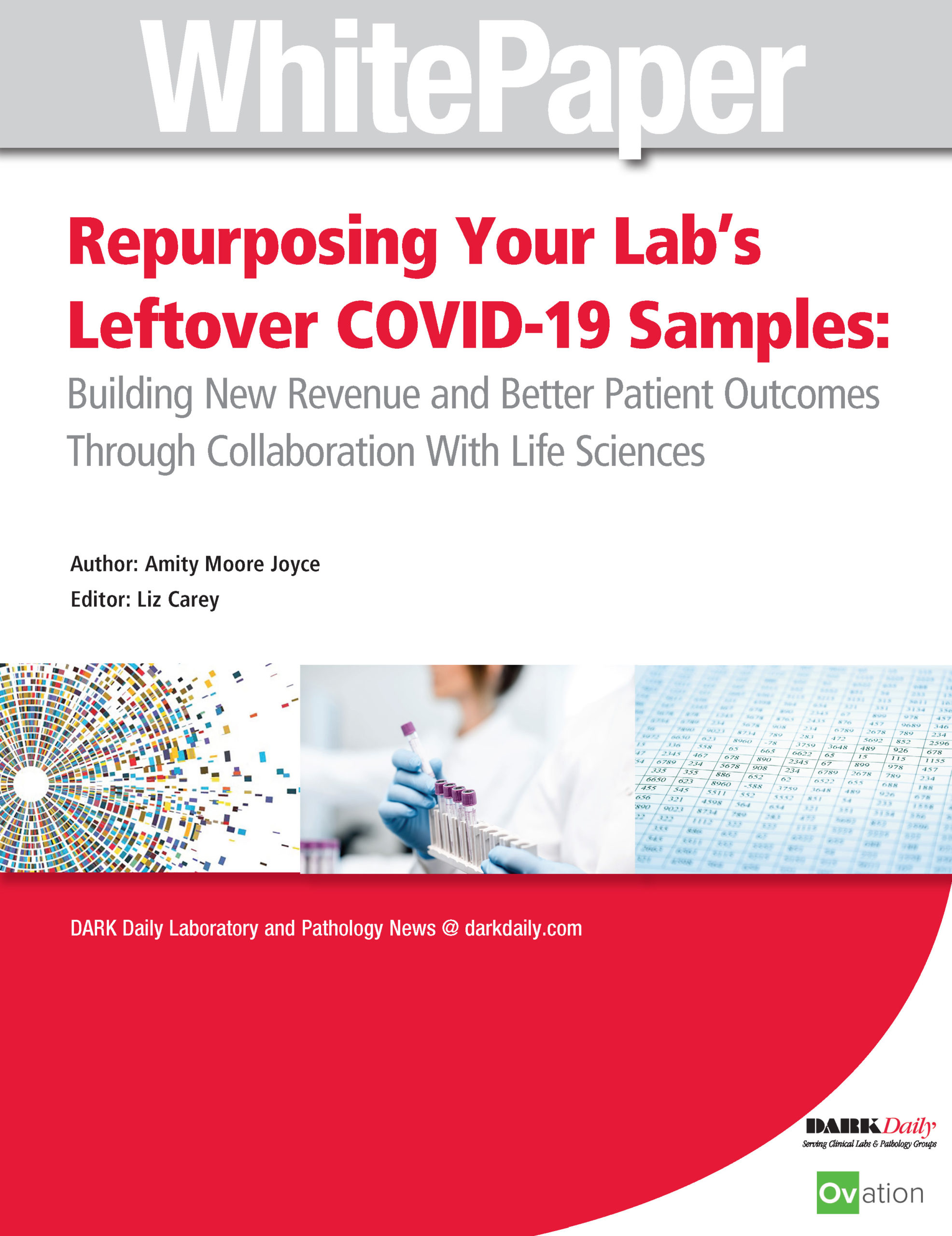


Portrait of a Microbiology Lab: Implementing Total Laboratory Automation in a Limited-Resource Environment

The Case of the Missing Mole: When costly Lost or Missing Laboratory Test Samples Instigate Courier Management Redesign

Anatomic Pathology: New Drivers Pushing Beyond Cloud to SaaS Laboratory Information Systems

FREE WHITE PAPER | 18 Pages
Produced in Partnership With:

Deciding how to upgrade your legacy laboratory information system (LIS)?
Anatomic pathology laboratory leaders are faced with hard decisions and conflicts over whether to keep their on-premises legacy laboratory information system (LIS), move to a hybrid model, or step up to a full SaaS (software as a service) LIS offering.
One compelling reason, among others, that labs do consider LIS alternatives is the difficulty of managing and keeping up with necessary software updates, security, sizing, and other information-technology needs of their current systems.
This white paper will assist pathology leaders in gaining a complete understanding of how a true SaaS LIS can overcome today’s pathology laboratory challenges while making key points to include in your organization’s internal cloud discussions. In addition, you’ll walk away with a better understanding of where your pathology laboratory stands with respect to its own cloud journey.
Table of Contents—Chapters at a glance
\art 1: Key Differences Between Cloud-Hosted LIS and SaaS LIS
As cloud and software as a service (SaaS) models are not an uncommon software delivery model, the majority of pathology laboratory professionals are unaware of the actual differences between a cloud-hosted laboratory information system (LIS) versus a SaaS LIS. Learn the key differentiators.
Part 2: Three Business Objectives Realized Through SaaS LIS Technology
There are many opportunities with a SaaS LIS. Facilitate team discussion by starting with your pathology laboratory’s needs in these three business objectives that are realized by migrating to SaaS.
Part 3: Essential Steps for Making the Move to a SaaS Laboratory Information System
As pathology laboratories and practices better understand the advantages of moving from an on-premises LIS to a SaaS LIS, more will choose to migrate their existing setups to systems that have reduced complexity with new capabilities that help them meet the requirements of ever-evolving payment and regulatory structures and changing data management needs. Migrating to a SaaS LIS comes with many questions. Learn four essential steps and the top 10 questions to ask a vendor.
The Dark Intelligence Group is committed to protecting and respecting your privacy, and we’ll only use your personal information to administer your account and to provide the products and services you requested from us. From time to time, we would like to contact you about our products and services, as well as other content that may be of interest to you. In exchange for providing this free content, we may share your information with the companies whose content you choose to view. By accessing the white paper, you’re agreeing to the above.
You can unsubscribe from these communications at any time. For more information on how to unsubscribe, our privacy practices, and how we are committed to protecting and respecting your privacy, please review our Privacy Policy.

Prioritizing a Digitization Project in Your Clinical Laboratory: Where, How, and Why Other Labs Made Changes

FREE WHITE PAPER
Published October 6, 2021
Author: Liz Carey
Advisor: Maureen Harte, MT(ASCP)
Produced in Partnership With:

How do you implement a digitization project in your lab? Learn from the success of two organizations.
Produced in partnership with Kapios
In clinical laboratory inspections, instrument maintenance and service visit documentation rank among common deficiencies cited by The Joint Commission, the College of American Pathologists (CAP), COLA, and the Centers for Medicare and Medicaid Services (CMS). While a majority of the time lab techs are diligent about the required maintenance and responsibilities of laboratory equipment, instruments, and analytical systems, the checkoffs are often left to finish later.
No one will dispute that accuracy in clinical lab test result reporting and precision of the total testing process stand paramount in providing quality laboratory services. Those who know the lab environment well would also probably acknowledge that an essential piece of a lab’s defensibility in a challenge is showing proper documentation of laboratory instrument maintenance logs and other required records.
Unfortunately, the reality is such that laboratory managers must run through miles of paper trails looking for evidence of regulatory compliant records of instrument maintenance and other checks.
The goal of this white paper is to demonstrate how some clinical lab directors and technical supervisors sought to relieve the unnecessary labor and hazards in one of the most common analog-world bottlenecks—and were successful. This white paper also identifies three commonly overlooked existing resources for taking the first steps to streamline instrument checks and documentation in the lab today.
Table of Contents
Part 1: Framing a Path to Digitization as Part of the Clinical Laboratory Quality Control Plan
Whether or not large-scale digital transformation of the clinical laboratory is on the immediate horizon or further in the distance, how does the conversion to digitization of lab equipment management processes materialize?
Part 2: Small-scale Digitization Projects: Where, How, and Why Other Labs Made Changes
Some hospital and health system laboratories have transitioned to paperless systems for projects and jobs such as quality assurance (QA) monitors, online quality control (QC) reviews, remote temperature monitoring, and cloud-based document management. Lima Memorial Health System in Lima, Ohio, is one such hospital laboratory operation.
Produced in partnership with:

The Dark Intelligence Group is committed to protecting and respecting your privacy, and we’ll only use your personal information to administer your account and to provide the products and services you requested from us. From time to time, we would like to contact you about our products and services, as well as other content that may be of interest to you. In exchange for providing this free content, we may share your information with the companies whose content you choose to view. By accessing the white paper, you’re agreeing to the above.
You can unsubscribe from these communications at any time. For more information on how to unsubscribe, our privacy practices, and how we are committed to protecting and respecting your privacy, please review our Privacy Policy.

Repurposing Your Lab’s Leftover COVID-19 Samples: Building New Revenue and Better Patient Outcomes Through Collaboration with Life Sciences

FREE WHITE PAPER | 24 Pages Published May 26, 2021
Produced in Partnership With:

The precipitous drop in COVID-19 testing leaves clinical lab leaders wondering, “What comes next?” So it’s time to pivot—again.
When the pandemic hit in March 2020, clinical labs faced a sudden halt in routine testing, and many were able to shift quickly to COVID-19 test offerings. Fast forward one year: with the COVID-19 vaccine rollout, SARS-CoV-2 testing in clinical laboratories has rapidly declined. In the United States, COVID-19 testing dropped from two million per day in January 2021 to only about one million by March.
Now labs are having to adapt again, leading forward-looking lab managers and directors to ask:
- What will be the new balance between testing for SARS-CoV-2 and routine diagnostics?
- Should my clinical laboratory even continue testing for coronavirus?
- Where is the best opportunity to generate revenue now?
- How do I transition my lab effectively—and efficiently—to best serve patients and the healthcare industry as a whole?
This white paper, Repurposing Your Lab’s Leftover COVID-19 Samples: Building New Revenue and Better Patient Outcomes Through Collaboration with Life Science, answers these questions and more. It explores how the rapid decline in SARS-CoV-2 testing affects molecular laboratories and the life sciences industry as a whole and offers opportunities for drug developers and labs to work together in new and beneficial ways.
Biospecimens present a win-win proposition for both the clinical lab and life sciences industries
As researchers on the life-science side study coronavirus and other diseases, the value of accumulated biosamples is being reevaluated. UCSF Professor Scott VandenBerg, MD, PhD, draws the connection: “Biospecimens are important because they allow researchers to better understand the causes of diseases and evaluate potential therapies.” Labs have always retained biospecimens, but COVID-19 has spotlighted their value.
Drugmakers are expected to prioritize the development of therapeutics for new patient cohorts, such as long-haul COVID-19 patients while verifying the fidelity of biomarkers used to identify and treat comorbidities. Data generated from analysis of leftover COVID-19 samples that labs can provide could dramatically accelerate this process.
This white paper examines how molecular laboratories can generate new revenue while also contributing to the greater good of society. One primary way to achieve both is to harvest more value from samples through new relationships with life science companies and biobanks. In these new business arrangements, labs would also benefit because instead of paying to dispose of their leftover COVID-19 specimens as regulated medical waste, they could biobank them at little to no cost.
Table of Contents—Chapters at a glance
This 24-page white paper, Repurposing Your Lab’s Leftover COVID-19 Samples: Building New Revenue and Better Patient Outcomes Through Collaboration with Life Sciences, includes the following main chapters:
Chapter 1: COVID-19 Testing: What’s Next After the Rapid Ramp Up and Sudden Decline?
While many labs initially lost revenue when routine testing crashed with the pandemic shutdown, the seemingly unending demand for SARS-CoV-2 testing helped labs rally as they pivoted from traditional diagnostics to COVID-19 testing. Some labs reported exceptional year-over-year revenue growth. At least 48% of clinical labs adopted new testing methodologies or automation to meet the demands of COVID volumes, and many startup and pop-up labs were launched, pointing to a significant investment in COVID testing alone. This chapter examines where we are now and what might be ahead now that COVID-19 testing is winding down.
Chapter 2: Looking Beyond COVID-19 Testing to Find Residual Value and Revenue in Collected Specimens
To stay profitable and relevant, every clinical and molecular laboratory’s short-term and long-term strategic planning must consider the evolving nature of the pandemic. This chapter covers what labs should consider as they evaluate how to repurpose their COVID-related assets, including equipment, molecular testing platforms, and COVID-19 specimens themselves.
Chapter 3: Key Points of Molecular Laboratory Diversification into Biobanking
Biobanking can be a positive thing for labs—for example, to supplement revenue, advance research, and lead to other business development in the lab services space. But it also has its challenges. This chapter discusses both the potential benefits of biobanking and the hurdles labs can face, including regulations, logistical difficulties, consent, collecting and managing samples, and building relationships with industry and research partners.
Chapter 4: The Role of LIMS in Biobanking
Questions often surround the value of a sample, such as: How was the sample collected from the patient? How was it stored? Is the label still secure? When will the sample expire and no longer be considered valuable for research? For labs trying to organize their samples and have at-a-glance answers to questions about them, a proper laboratory information management system (LIMS) or laboratory information system (LIS) streamlines the process. This chapter covers what lab managers and directors should consider as they look to strengthen their quality systems to validate and verify their samples and tests.
Produced in partnership with:

The Dark Intelligence Group is committed to protecting and respecting your privacy, and we’ll only use your personal information to administer your account and to provide the products and services you requested from us. From time to time, we would like to contact you about our products and services, as well as other content that may be of interest to you. In exchange for providing this free content, we may share your information with the companies whose content you choose to view. By accessing the white paper, you’re agreeing to the above.
You can unsubscribe from these communications at any time. For more information on how to unsubscribe, our privacy practices, and how we are committed to protecting and respecting your privacy, please review our Privacy Policy.



